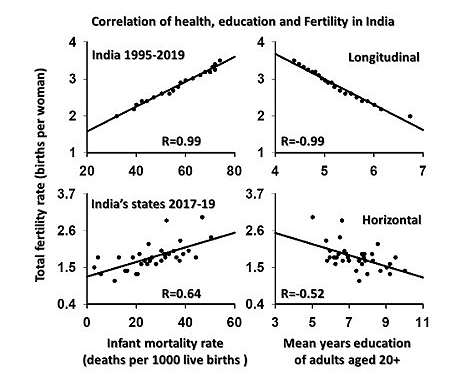
In April, the United Nations estimated that India had overtaken China as the world’s most populous country. While the announcement received a great deal of media attention, India’s 2024 census will likely reveal that the UN’s projections have been vastly overestimated.
According to India’s most recent census data, the country’s population stood at 1.03 billion in 2001 and 1.21 billion in 2011. The UN’s 2022 World Population Prospects (WPP) report, however, put these figures at 1.08 billion and 1.26 billion, respectively. Moreover, India’s National Family Health Survey indicated a fertility rate of 1.99 in 2017-19, in contrast to the WPP’s estimate of 2.16.
At the 1974 UN population conference in Bucharest, India’s then-Minister for Health and Family Planning, Karan Singh, famously said, “Development is the best contraceptive.” While it is often assumed that income per capita is directly correlated with fertility, declining fertility rates are primarily driven by improvements in health and education, along with the wider availability of contraceptives. This trend is evident in India, where the fertility rate has plummeted in tandem with reductions in infant mortality and rising education levels.
These patterns also emerge when comparing different Indian states:

India’s development indicators have improved markedly since its previous census. From 2011 to 2021, the country’s infant mortality rate fell from 44 deaths per 1,000 live births to 27. The secondary-education gross enrollment rate rose from 66% to 78%, and the mean years of schooling among adults aged 20 and older increased from 5.8 to 7.2 years. The contraceptive prevalence rate rose sharply from 54% in 2013-15 to 67% in 2017-19. Consequently, India’s fertility rate may be as low as 1.6-1.7 in 2024, with its population ranging between 1.37 to 1.39 billion, compared to the 1.44 billion projected by the UN.
The WPP projects that India’s fertility rate will bounce back to 1.78 in 2050 before declining to 1.69 by 2100. But in countries such as Singapore and Malaysia, the fertility rates of Indian populations are barely higher than those of Chinese communities. For example, between 2000 and 2022, the average fertility rate for Indians and Chinese in Singapore was 1.19 and 1.09, respectively. Similarly, from 2016 to 2021, the average fertility rate in Malaysia was 1.1 for Chinese and 1.23 for Indians.
But, absent a socioeconomic paradigm shift, it is likely that India’s fertility rate will drop below 1.2 by 2050, and its population will peak below 1.5 billion, rather than the 1.7 billion projected by the WPP. Fast-forward to the dawn of the twenty-second century, and the numbers paint an even bleaker picture. While the UN report estimates that India’s population will reach 1.5 billion by 2100, the country’s population could actually fall below a billion.
The WPP’s projections of Chinese demographic trends are even more exaggerated. For example, the 1992 WPP estimated that China’s population will reach 1.54 billion by 2025. While the 2022 report revised this figure down to 1.42 billion, the actual figure will likely be closer to 1.27 billion. Likewise, the 1996 report projected that the Chinese population will increase to 1.52 billion by 2050, but the 2008 report revised this forecast to 1.42 billion, and the 2022 edition further reduced it to 1.31 billion. When it comes to 2100, the 2019 WPP projected a population of 1.06 billion, but the 2022 report adjusted this to 767 million.
These constant revisions have undermined the trustworthiness of UN demographic data as a source for insights into Chinese socioeconomic trends. Nevertheless, China’s official demographic figures are heavily influenced by UN projections, as Zhang Weiqing, the former director of China’s National Population and Family Planning Commission, confirmed in 2006. Moreover, You Yunzhong, a former deputy director for demographic and social statistics at the UN’s statistics division, has been overseeing China’s censuses since 1982.
Should India’s 2024 census reveal that its population is significantly smaller than the WPP’s projections, the reliability of the report’s projections for still other countries would be called into question, further discrediting the survey as a credible source for studying the world economy.
In addition to overestimating the populations of China and India, the UN has financially supported both countries’ population-control policies. In 1974, the UN Population Fund (UNFPA) provided India with $40 million, and then-Prime Minister Indira Gandhi introduced a series of radical measures to manage the country’s population growth, resulting in the forced sterilisation of roughly eight million Indians. Fortunately, voters removed Gandhi from power in 1977, leading to the abolition of these policies.
After India, UNFPA shifted its attention to China, providing $50 million in 1979 – a substantial sum, given that China’s foreign-exchange reserves at the time totaled just $167 million. The funds were used to implement China’s one-child policy. Under the iron fist of Health Minister Qian Zhongxin, sterilisations soared from 2.2 million in 1981 to 20.7 million in 1983, and abortions surged from 8.7 million to 14.4 million. In 1983, UNFPA presented the first UN Population Award to Gandhi and Qian, in recognition of their contributions to population control.
While UNFPA has consistently defended the Chinese stance on population control, the United States has repeatedly withdrawn funding from the agency, citing its alleged support for forced abortion and sterilisation. China’s rigid decision-making, together with the UN’s inflated population data, contributed to the delayed abolition of its one-child policy, which was rescinded only in 2016. Yet, despite China’s ongoing population decline, the country has yet to abolish its population-control measures.
Both China and the West face an aging crisis that could threaten their stability. While this crisis was partly caused by UNFPA’s support for population control, the agency’s tendency to create problems rather than solve them may reflect deeper organisational shortcomings. To grapple with the challenges of aging populations and prevent a painful economic slowdown, the UN must undertake significant reforms of its costly, inefficient, and often inaccurate demographic bodies.
Yi Fuxian, a senior scientist in obstetrics and gynecology at the University of Wisconsin-Madison, is the author of Big Country with an Empty Nest. Copyright 2023 Project Syndicate, here with permission.
15 Comments
The is well covered by Peter Ziehan in his latest book. Makes the case for China to be write off due to demographics. One child policy and low birthe rate since. Russia in the same boat.
My only issue with his book is it seems overly reliant on assuming the United States will retract inwards, stop patrolling shipping lanes, and fully deglobalize.
If that does happen I could see his conclusions coming to pass. But he is very bullish on the US which he does have some solid reasoning for, but it's probably worth getting some contrasting viewpoints to balance his views out. I recently read Kevin Rudd's book "The Avoidable War" and he had some contrasting views to Zeihan which was interesting. I also think Rudd has a much better understanding of China and its culture as opposed to Peter who is coming from a very Western viewpoint without a great understanding of China itself other than demographics.
I think demographics are going to be a massive part of the coming century though, and we are entering some very uncertain times.
Demographics and geography Ziehans focus for sure. Perhaps i need to read Rudds book.
Declining fertility? Great news! Too little, too late, but maybe we can get through the resource/pollution bottleneck as a species?
Good article!
All of those global big agencies need to shove right off. They are unelected anti humanity villain's and their agendas are pretty clear to see.
[ Nutty conspiracy removed. Don't do it. Try and stay grounded in reality. Ed]
We need a thumbs up ability, for editors edit commentary thumb
Editorial policies that scrub conspiracy theories only serve the conspiracy theorists who can now point to the censorship. Other commentors could have attempted a reasoned debate with this person... or putting hubris aside, at least see where his or her viewpoint has merit.
Totally agree. Not a fan of censorship. Plus we all need a few laughs on a daily basis. I am sure we can make up our own minds without the need to delete comments. Oh, and I am really curious now!
alphabeatrium,
I agree. Assuming the post is not abusive, then the editor has no business in censoring it. Who is he to decide what is or is not a conspiracy theory? We are sufficiently grown up to make our decisions.
Conspiracy theories are seldom grounded in any kind of reason, so reasoned debate is unlikely to be effective. Conspiracies tend to make accusations and assume guilt before innocence, because they don't have to provide any facts to support their point of view. The onus of proof should always lie with those making the accusations.
Or that's what the Lizard underlords told me to write. Prove me wrong :)
Have you ever gone to their website and watched their videos?
They literally brag about it.
Good on the US for withdrawing support for forced abortions and sterilization. Funding this sort of thing is very ill-conceived. Let countries pave their own path to Hell.
Ziehan is an interesting character. He loves the South Island of NZ. Hard to fault his arithmetic at the end of the day. He hopes for the best in the US of A as we all do. I have one caveat: If the flat earthers at the western universities continue on their woke journey for much longer then we're in big trouble. We need quality as well as quantity.
Auckland council was unable to predict its population growth over the last two decades; probably the UN has better statisticians but any prediction for 2100 is a waste of effort. Even a time machine giving the exact population 1st Jan 2100 would be meaningless without knowing distribution and well-being.
Can he phrase 'aging crisis' be dopped. Consider the opposite - how about 'Death contentment'?
People living longer (eg myself survivor of heart attack or my wife survivor of cancer) is a good thing not a crisis. Economists see things differently; so for them slavery is good if it increases GDP. Elderly people lose their physical strength while retaining or even increasing their wisdom. 200 years ago the economy needed muscle but now it needs judgement so we are lucky to have an older society.
The phrase about 'the challenges of aging populations' is fair enough but the challenge relates to retiring when still capable of work and the demands on expensive medical treatment in roughly the last year of life. The challenge is not age itself otherwise why would governments invest in twenty years of education for people with short lifespans.

We welcome your comments below. If you are not already registered, please register to comment
Remember we welcome robust, respectful and insightful debate. We don't welcome abusive or defamatory comments and will de-register those repeatedly making such comments. Our current comment policy is here.